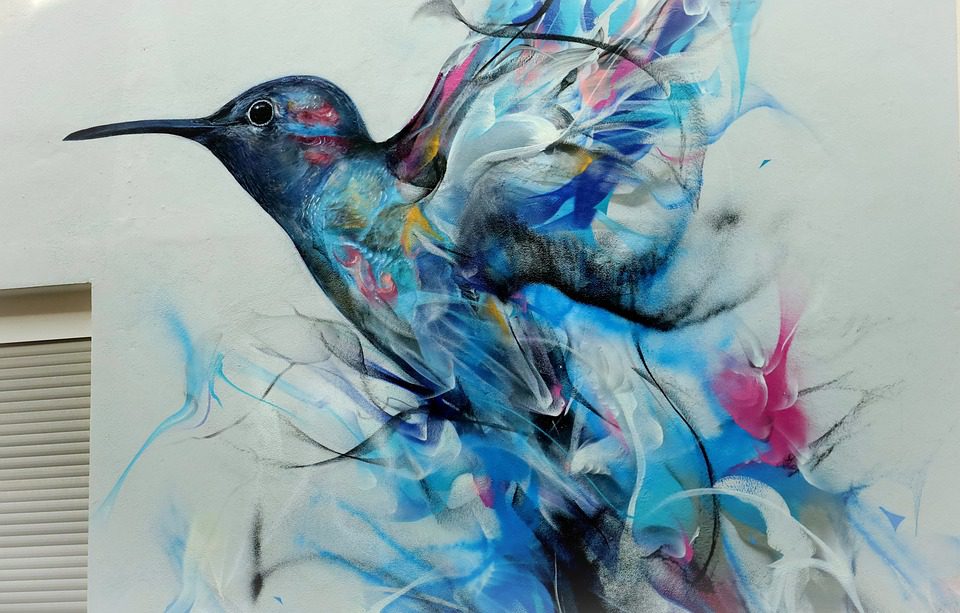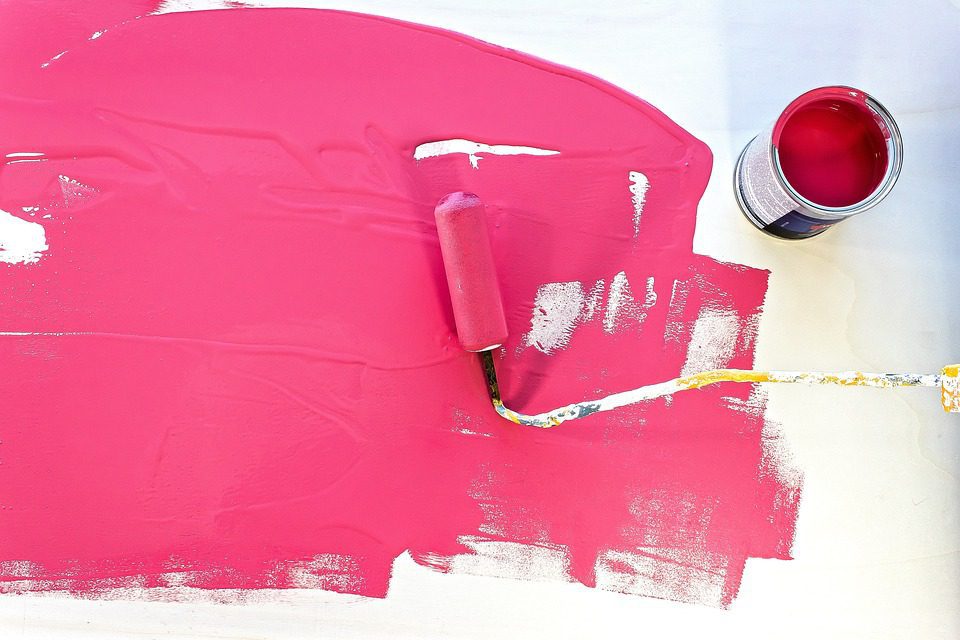Getting ready to start oil painting for the first time?
The best oil paints will give you a helping hand.
You don’t have to start out with a budget-busting set of paints; we’ve found the best priced and more effective oil paints for the value.
Getting dollar store paints are going to result in lackluster paintings, and that’s not a proper way to assess your skill and improve it.
Grab one of these 4 oil paint sets, and you’ll be on your way to your own personal home gallery littered with works of art.
#1 Williamsburg Oil Native Italian Earth Set
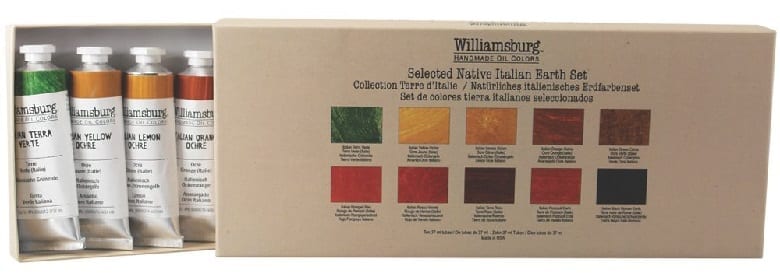
Starting with the very best, Williamsburg is designed to bring the widest spectrum of color imaginable without meeting the prices of brands like Holland and Harding.
Having multiple tubes is great, but with these ten simple colors, you’re able to mix and match a bold array of colors that transcend what is on the box.
Williamsburg paints aren’t the cheapest, but there’s nowhere else that offers this level of consistency and thorough pigmentation for this price range.
You’ll find that similar quality brands hike up the prices because they know what they’re worth, but Williamsburg wants to put the power of better paint in your hands.
These blend on the palette remarkably well without having a long trail, so you won’t have to scoop and scrape in order to get the paint off the palette.
Robust, full colors that are true to the packaging, in airtight tubes that prevent rapid oxidation. These will meld well together, and dry decently fast on the canvas.
- Number of Paints: 10
- Tube Volume: 1.25 oz each
- Glossy Finish: No
- Made In: United States
#2 Winsor & Newton Oil Colours
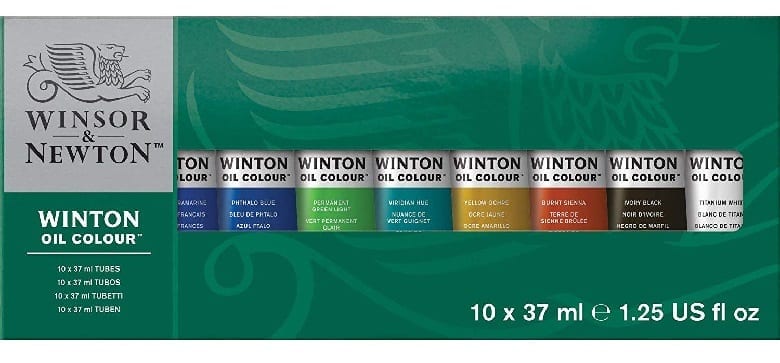
As a close second, Winsor and Newton’s winton set comes in at a much lower price, and offers a wide range of full bodied colors.
Between the burnt sienna and viridian hue, you’ll be able to blend your titanium white paint to make a myriad of different shades.
These are some of the most versatile oil paints on the market, and they came seriously close to taking the top spot from Williamsburg for that.
But it’s more than just the colors.
There’s a very slight variation in the different finishes of each paint, bordering between low and high glossy.
All of these paint a quite literal gorgeous picture, especially when your blend paints together.
You’ll find those in-between finishes from the blues and greens, and get an added boost of luminosity from the titanium white.
When oil paint oxidizes, it’s a pain to get out of the tube.
That’s why Winsor & Newton made this set in metal tubing to prevent that from happening, with an airtight seal on top (even after you reclose it).
We’ve selected their starter set here, but there are also an intro, basic, and studio set to choose from if you’re looking to upgrade your painting game.
- Number of Paints: 10
- Tube Volume: 1.25 oz each
- Glossy Finish: Yes, varies
- Made In: London, England
#3 ZenART’s Essential Palette Oil Paint Set
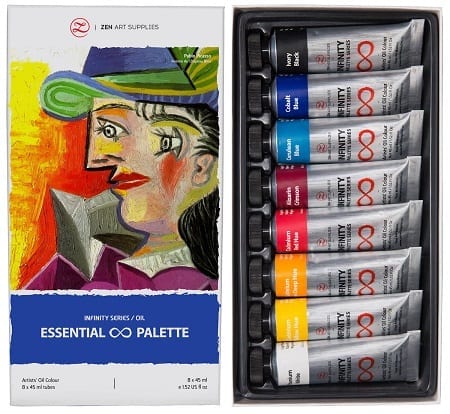
ZenART is a great company with a focus on keeping things as family-friendly as possible.
These paints are non-toxic (see more about paint toxicity in the guide below), and come in a wide range of excellent colors that you can mix and match.
You’re given a titanium white and ivory black, and a varying boldness of the colored paints so you can mix and match as you see fit.
These paints from from ZenART’s infinity palette series, because they’re very easy to dilute, and could theoretically last forever.
There’s strong, thick pigments in here, as well as metal tubing that can withstand multiple temperature ranges.
Thanks to the airtight cap, you can practice on small canvas panels from time to time, and seal up your paint so it’s as good as new.
You won’t have to worry about a short-term lifespan on your paints after initially opening the tubing.
It should be noted that ZenART is also an ethical company with a one-year warranty and a 100% money-back guarantee, which is difficult to find in usable products like paints.
- Number of Paints: 8
- Tube Volume: 1.52 oz each
- Glossy Finish: No
- Made In: United States
#4 Castle Art 24 Tube Oil Paint Set
Best For The Money
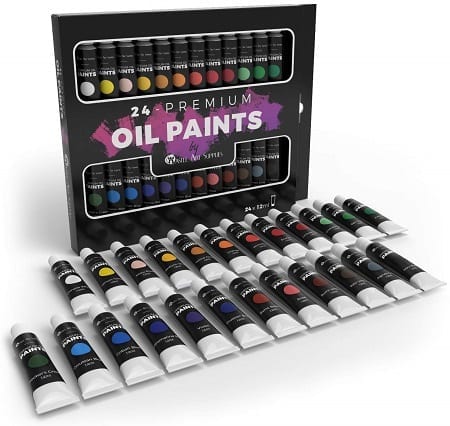
Castle Art Supplies have been one of those American staples for paint for years, and it’s for a good reason.
While they’re not premium, they are excellently priced and beautifully colored.
These remain vibrant, and are not quick to dry, so you won’t have to worry about rushing yourself once they’ve been dropped onto your palette.
With twenty-four colors, you’re given a lot more to work with, and more color variations that you can create.
If you’re going to blend these together, you’ll be glad to know there’s no glossy effect, so everything will seamlessly mesh together.
You get what you pay for, and with Castle’s twenty-four tube set, it’s volume.
The quality is fair, the colors are vibrant, and the amount you get for such a low price is perfect for beginners and those looking to pad their paint set until they can get their hands on a higher tier brand, like Williamsburg.
- Number of Paints: 24
- Tube Volume: 0.4 oz each
- Glossy Finish: No
- Made In: China
Introduction to Oil Painting

Oil painting is one of the more difficult forms of painting, but offer a much better range of creativity.
They are the opposite of acrylic paints, and come with a different mixing process.
You can either use a brush with a palette, or use a palette knife to create unique textures and designs in your canvas.
Oil painting is one of the oldest in history, and is responsible for numerous fantastic works.
Oil Paints FAQ
Most common questions asked about oil paints:
How do You Start Oil Painting?

Pick up a brush, and get to it.
There are three main ways you can oil paint, and they’re all very simple.
Pick one of these three techniques, and you’ll be able to paint endless pictures.
- Dry Brush: Bringings the brush lightly against the canvas to create a pixelated, slightly porous look to your art.
- Impasto: Broad strokes with thick paint, generally used in abstract pieces where definition and detail are not priority.
- Alla Prima: Multiple layers with thin brush strokes and paint. These create more cohesive, less “choppy” looking pieces with intricate landscapes and buildings.
Select whatever seems the best to you, and run with it.
Each serve different skill levels, artistic visions, and have their own levels of fun associated.
Stick with dry brush for thicker, more coarse art; impasto for abstract pieces that can be done in one go; alla prima for very fine and precise artwork with a lot of definition.
Do You Use Water with Oil Paints?
It depends on the type of paint.
If you get a water-soluble paint, it can be mixed with water to dilute it and lighten the colors.
This also stretches your quantity, so you don’t have to use as much actual oil paint out of each container.
But then there are some that cannot be mixed with water.
Those are ready to use right out of the tube.
It’s about convenience versus skill level.
Water-soluble oil paints are generally perceived as requiring more skill to mix, but create more textures.
Non-soluble oil paints are convenient, but offer slightly less dynamic and artistic range.
What do You Need for Oil Painting?

The first thing you need is a dream, then the best oil paints for artists.
If only it were that simple, though.
This is a brief of everything that you’ll likely need as you come across different methods of oil painting
Brushes
This seems basic, but you need specific brushes.
The ones at the dollar store won’t do, but that isn’t to say that you have to spend a lot of money on proper brushes.
You can get a set of student grade bristle brushes, just be sure to have varying sizes so you can carry out fine detail with absolute precision.
Thinner
You can use natural thinners or turpentine, but paint thinner is generally seen as a must-have.
Even if you don’t use it often, it’s good to have on standby when you’re using lower grade paints that come out a bit too vibrant or bold.
Working with paint thinners require masks, gloves, and a well ventilated area, so do be certain that you know what you’re doing prior to popping the can open.
Newspaper
It’s not often that you have a newspaper laying around the house anymore, but it’s actually super useful.
You need to continuously clear off your brush, and nothing is better to do that than newspaper.
Paper towels not only tear and get stuck to the paint, but they generally cost a lot more to keep disposing of them.
Newspaper is tough enough to not tear, and inexpensive enough to not be an issue.
Charcoal Pencil
Ever heard of an outline?
Even some of the best artists in history didn’t just free-hand their oil paint on the canvas; they outlined it, and with charcoal pencils or rocks.
These are the most reliable to stick to paper, canvas, and just about anything else, while properly imbuing into oil.
It’s rare to really see the outline once the painting has been completed, making them great for masking your early stage conception.
Palette
What is an artist without their palette?
It isn’t just about aesthetics or the romance of painting, but it is about having access to your paints without having to constantly bend down and dip your brush into plastic containers.
If you don’t have a palette yet, don’t worry; they’re not expensive, and you can even make a DIY one if you’re strapped for cash.
What is the Best Canvas for Oil Paints?
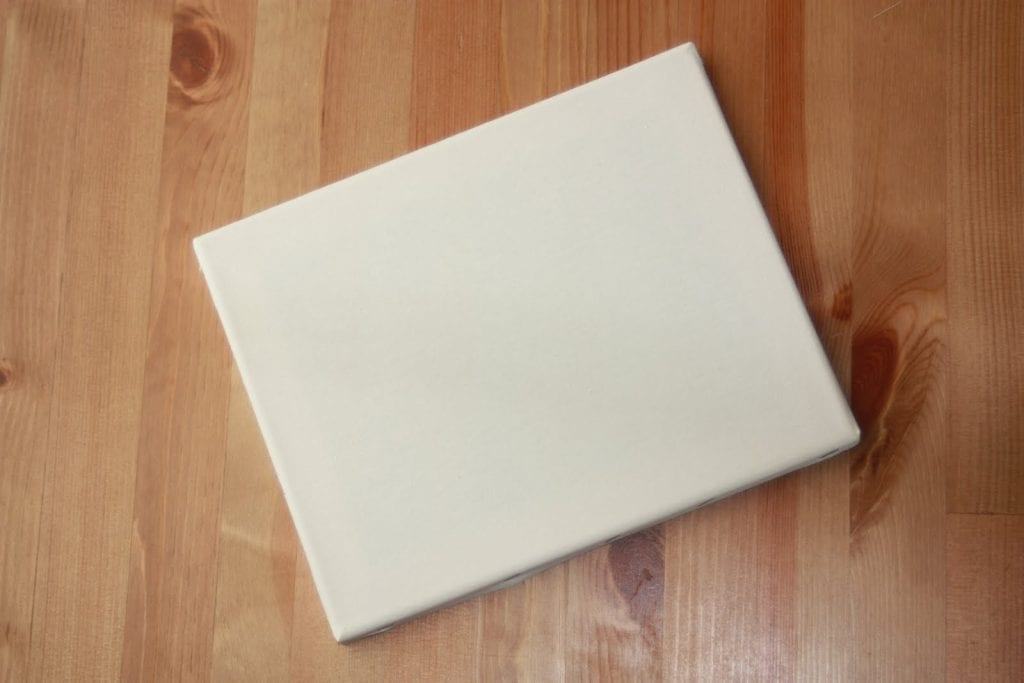
Good oil paints need a good canvas to be applied to.
Fortunately for you, there are two main canvas types that are going to work well for oil paints.
The first would be a stretched canvas, which is designed to offer great resistance while painting and allow the colors to dry evenly.
These are the most common type of canvases, with the birch wood frame underneath the stretched edges.
Then you have canvas panels, which are more affordable and come in smaller sizes.
These come with full backings, so you’re not going to get that same elasticity and resistance of a gesso-finished stretched cotton canvas, but it will still do the trick.
If you’re buying in bulk, you can get a lot more surface space for panels compared to stretched canvases.
Lastly, you can also use oil paint paper as well, though the prices will vary depending on the grade that you select.
You’re looking at smaller sizes than canvases, but about the same size s canvas panels, making this a wonderfully viable choice if you have a small workshop or creative space.
Are Oil Paints Dangerous?
Some of the best oil paint brands use some seriously harmful chemicals in their oil paint.
You’ll find a bunch of online blogs about mothers who say “Oil paint isn’t dangerous, turpentine is,” but they couldn’t be more wrong.
Oil paints are dangerous if you don’t know what you’re doing.
Just follow these simple rules when using oil paints to avoid skin irritation or problems.
Work in a Well Ventilated Area
There’s never been a time where someone said, “Inhale those fumes, it’s good for you.” If they’re called fumes, it’s relatively safe to assume you shouldn’t be breathing them in.
Open the windows, get a fan blowing away from the painting, and work in a large space. You don’t want to be stuck in a room with a lot of paint fumes.
Use Gloves
Yeah, it’s not the most aesthetic way to be seen painting a picture, but avoiding skin contact is your best bet.
Some oil colors are mixed with materials like cobalt and manganese, which are toxic, and some pigments are even made with things you would never expect, like dirt and rust.
With oil paints, the higher price point is because some of the materials are naturally sourced.
Some dyes occur in nature and work well for paints, others are made by blending odd things together.
Keep it off of your skin.
Leave Out of Reach
If you have children or pets, they’re not likely to each the paints, but you never know.
Oil paints have a notoriously strong odor.
It isn’t always bad, but it is something that’s very noticeable and might beckon the attention of a small child or a dog.
If you’re leaving your workspace for even a minute, put your oil paints up high and make sure that none of it spilled on the floor.
Like a Surgeon
Clean up extremely well after you’re done painting.
We have naturally occurring oil on our hands at all times, even though we can’t see it; dangerous additives in oil paint could linger around just the same.
Before you go to eat anything, drink anything, prepare food or change your child, clean your hands like you’re going to be graded on it.
Choose Thinners Carefully
The biggest thing people want to avoid when oil painting is fumes and the odors that come with turpentine.
Well, it’s not wise to do so.
Most of the odorless paint thinners contain something called benzene, which is absolutely 100% linked to cancer.
It’s not “This product might cause cancer due to a California Prop 65”—it’s none of that, it’s actually proven to cause cancer.
Most odorless paint thinners are more harmful than odorous ones. Avoid these like the plague.
One last thing to keep in mind is that non-toxic does not mean safe to consume, it simply means it ranges below an acceptable toxicity level as described by the appropriate regulation committee.
In this case, it would be an ASTM rating.
What is an ASTM Rating?

ASTM International is a designed to test numerous products that are used in homes all across America, some of which include artists’ paints.
These ratings, while not commonly known, identify and disclose toxicity levels or the lack thereof in these products, such as in oil paint.
These ratings also work for acrylic paints and other artists’ tools.
Depending on what paint you’re purchasing, there might be a long history of usage with harmful materials, such as manganese, cobalt, and lead.
An ASTM rating is designed to disclose everything, and if you have a guide handy, you can immediately know if the product you are planning on purchasing contains any of these harmful ingredients.
You can find a full guide here.
Paint us a Picture
You can oil paint on just about anything, so what are you waiting for?
Grab a canvas, a slab of wood, or even different types of art paper.
The choice is yours, and the end result is completely up to your imagination, so let your skill guide you, and paint us a pretty picture.
Did you like the article? Please rate it:


